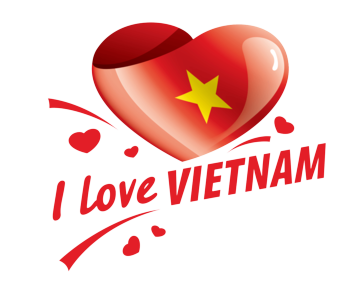When it comes to traveling to Hanoi, it’s to explore the famous landmarks such as Hoan Kiem Lake, West Lake, Temple of Literature, to learn about the thousand-year history and culture of the capital city, and not to miss the rich cuisine, showcasing the essence of the local people.
Hanoi has always been famous for its rich and renowned cuisine, with dishes like pho – a dish that has been immortalized in the writings of Thach Lam about the 36 streets of Hanoi or bun cha, a dish that is praised to be found at the end of the street with the aroma of grilled meat at the bun cha stall at the beginning of the street, or the delicate Thanh Tri rolled cakes, or more modern options like the Giang coffee shops, or the lemon tea stalls where you can chat with friends when the cold wind blows.
However, many out-of-town visitors or foreign tourists visiting Hanoi for the first time still feel anxious about being overcharged or yelled at. To avoid becoming a victim of this negative phenomenon, all you need to do is carefully read this sharing of experiences by Cuong.
1. Gifts that remind you of Hanoi
For those who have never been to Hanoi or are planning a trip to Hanoi with family or friends and do not know what delicious dishes or famous eateries are in Hanoi, Cuong will introduce you to some of the famous specialties of the capital city.
1.1 Pho
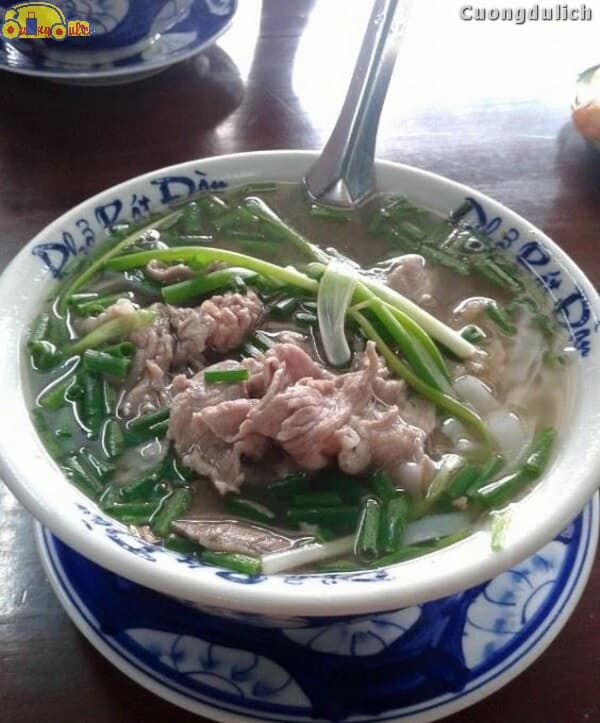
Pho is a must-try dish when visiting Hanoi. The famous beef pho that is delicious is Pho Ly Quoc Su. If you want to try chicken pho, head to the chicken pho stall on Quan Thanh Street. Experience the unique flavor of sweet and sour mixed pho at Pho Hanh on Lan Ong Street or the pho stall on Luong Van Can Street. Sizzling pho on Bat Dan Street. If you come to Hanoi and do not taste pho, it means you have not really set foot here.
Cuong would like to especially introduce you to a pho stall in Hanoi that is so popular that customers often have to wait in long lines to buy pho, that is Pho Bat Dan.
The address of the stall is 49 Bat Dan, open from 6:30 am to 8:30 am. Price: around 60k/bowl.
“Pho is a special gift of Hanoi, not unique to Hanoi alone, but because it is only in Hanoi that it is delicious” – writer Thach Lam once wrote about Hanoi pho. The traditional pho at 49 Bat Dan truly carries a special flavor and style that Hanoians can never forget no matter where they go.
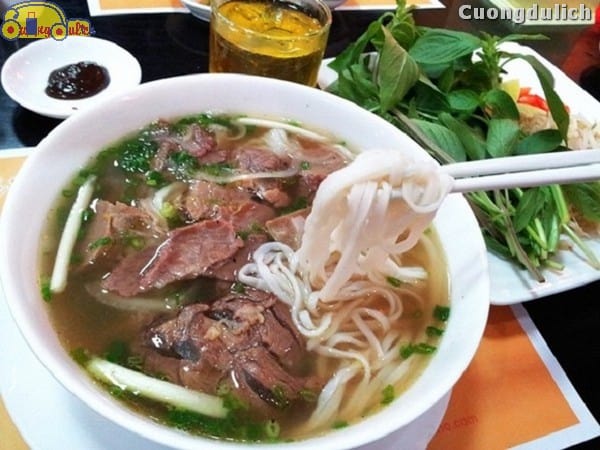
Eating pho at Bat Dan has its own charm, with delicious pho, freshly sliced beef, fragrant broth with a sweet taste of simmered bones, just like traditional Hanoi pho; but the most special thing is that customers have to line up and pay in advance, then carry the hot bowl of pho to their seats themselves. When going to enjoy pho at Bat Dan, it’s best to go in pairs, with one person buying the pho and the other holding a spot in line because the place is always crowded.
Thinking about lining up, don’t imagine a chaotic and crowded line where you have to tightly hold your wallet to avoid pickpockets, people patiently wait for their turn to enjoy a delicious bowl of pho, some even bring a newspaper to read while waiting.
The Bat Dan pho restaurant is quite small, low, with only rough wooden tables and chairs inside, old-fashioned, existing for almost half a century without much change. The pho kitchen is right near the entrance. A man skillfully slices thin but large pieces of fragrant cooked beef. The pieces of lean meat or fat are not too fatty but sticky like wax, crispy, not chewy, very appealing to the visual, olfactory, and gustatory senses of the customers. Squeeze a few drops of sour kumquat and a bit of spicy chili sauce, add a few pieces of fried dough, and you can delight in a hot bowl of pho on a cold windy day.
1.2 Bun dau mam tom
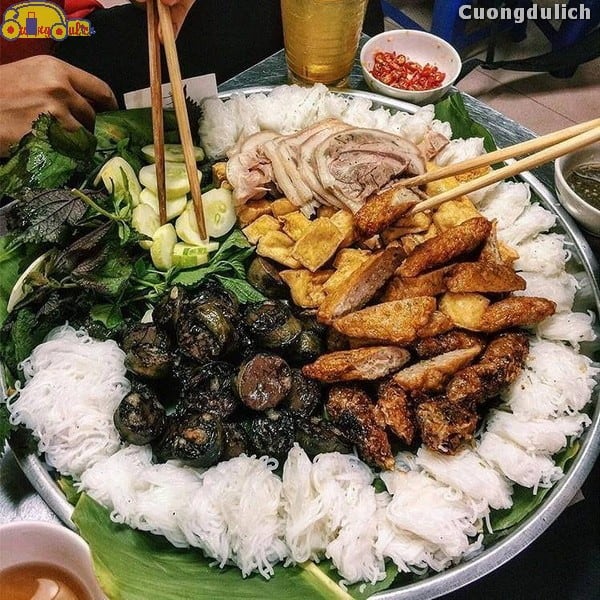
The most famous address for this dish is at number 55 and number 49 Phat Loc alley, right next to Hoan Kiem Lake. The characteristic of the bún đậu shrimp paste here is made from Phu Do small, white, elastic and smooth vermicelli, eaten cool and slippery in the throat, Thanh Hoa shrimp paste, golden crispy Mơ village tofu, fragrant Hanoi green rice cake…
If you wish, you can order a full bún đậu set with innards… The white color of the innards, pig’s intestines, the refreshing green of basil, perilla leaves and the round meat pieces, just looking at it makes you want to dive into the bowl without hesitation. The price for a full bún đậu set is around 50k.
Perhaps the soul of the bún đậu dish lies in the shrimp paste. The shrimp paste bowl is prepared according to the accumulated secret recipe of the traditional restaurants in Phat Loc alley, which is also very special. The purple-tinted shrimp paste bowl is mixed and poured with hot oil still emitting smoke. Just lifting the shrimp paste bowl, surely just a sniff makes everyone unable to resist. Good shrimp paste must be accompanied by lime, squeezing a lime slice, whisking the shrimp paste bowl, it seems that all the essence of Hanoi cuisine is encapsulated in this amazing shrimp paste bowl.
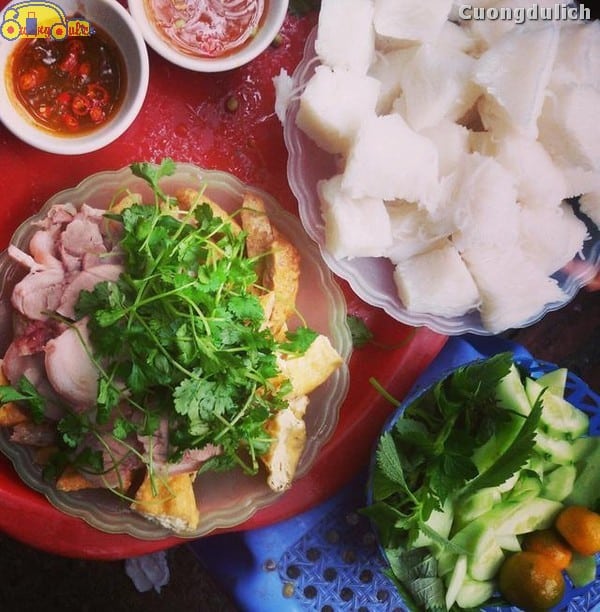
Furthermore, those addicted to bún đậu mắm tôm can also find other places in Hanoi to enjoy this favorite dish, such as Ngõ 31 Hàng Khay, the original bún đậu at Ngõ Gạch, and the bún đậu under the banyan tree at Đại La.
Bún đậu mắm tôm is also one of the famous delicacies in Hanoi that you shouldn’t miss. For Cuồng, bún đậu mắm tôm is a very rustic and popular dish in Hanoi. In any corner of the street, you can come across stalls selling bún đậu mắm tôm, lined up on the sidewalk to cater to all kinds of diners, from office workers to manual laborers… If you are not used to the shrimp paste, the restaurants also provide a dipping fish sauce, not as salty as the fish sauce at home but mixed with a sweet and sour taste, perfect for the noodles.
1.3 Bún chả
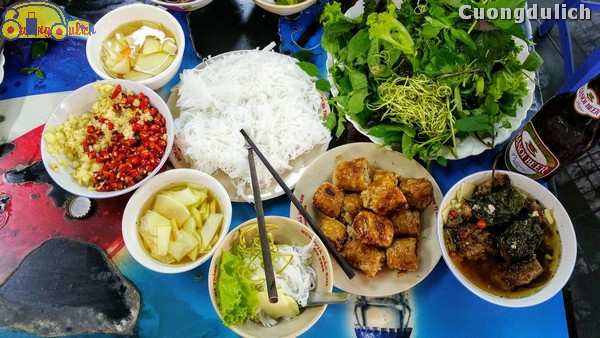
When it comes to delicious food in Hanoi, one cannot overlook “bun cha,” grilled pork served with vermicelli noodles, fresh herbs, and dipping sauce. The restaurants in Hanoi are skilled at grilling the pork to perfection, giving it a tantalizing aroma. Cuong finds that when he tries to grill pork at home, it often turns out dry and not as flavorful as the succulent and fragrant pieces served in restaurants.
The Old Quarter can be considered the belly of Hanoi, as it is home to many delicious eateries. If you want to taste authentic bun cha in Hanoi, you can visit Bun Cha Hang Manh (near the intersection of Hang Quat and Hang Non streets), Bun Cha Duong Thanh (near Hang Bong street), Bun Cha 47C Mai Hac De…
Dac Kim Bun Cha is perhaps the most famous bun cha restaurant in Hanoi, located at 1 Hang Manh street. Despite its small size, during peak hours, diners may have to sit on the upper floors or be seated on the sidewalk.
The name Dac Kim comes from the original owners of the restaurant in 1965. Today, it is run by subsequent generations in the family. One of the standout features here is the meticulous selection of ingredients. The pork must be pork belly or armpit, minced with a knife, marinated with spices, shallots, garlic, and delicious fish sauce before being grilled over charcoal. Each serving of bun cha at Dac Kim is prepared generously, with plenty of meat and costs between 50,000 – 60,000 VND. This is considered one of the oldest traditional bun cha restaurants in Hanoi.
1.4 Cha Ca La Vong
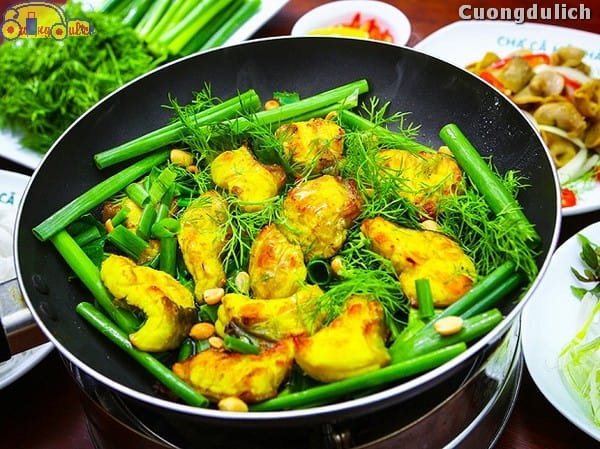
Visiting Hanoi without trying the famous Cha Ca La Vong dish would be a missed opportunity. This dish is interesting because at the dining table, there is a small stove to keep the fish hot. Diners will personally grill the fish, add some accompanying herbs, creating a dining experience that feels like a festive home-cooked meal.
The fish is fried in a small pan, and each table has a small charcoal stove with the fish pan on top. The fish is served with grilled rice paper, vermicelli, roasted peanuts, coriander, dill, scallions, and fresh sliced onions dipped in shrimp paste. The shrimp paste is prepared by squeezing fresh lime juice, adding chili, whisking it until foamy, then adding a bit of essence of giant water bug, a few drops of white wine, some lard, and sugar.
The dish has a rich, sweet, and fatty flavor from the snakehead fish. Diners mix the onions and herbs into the pan. They scoop a small forkful of vermicelli into a bowl, add some peanuts, a sprig of herbs, a piece of fish, and some sautéed onions from the sizzling pan, drizzle shrimp paste on top with a small spoon, and begin to enjoy. Only when all these elements blend together does the famous taste of Hanoi’s specialty truly come alive.
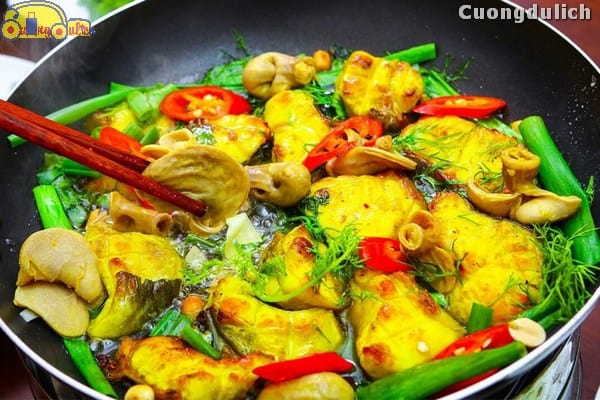
Most foreign tourists visiting Hanoi want to enjoy this dish, so they often visit the Lã Vọng fish cake restaurant, which is over 130 years old. The fish cake at Lã Vọng restaurant is mainly made from snakehead fish and carp, so the meat is firm and chewy, not falling apart when flipped multiple times in the pan. The fish slices are just right, turning golden and slightly crispy when cooked. They are crispy on the edges but tender in the middle, seasoned to perfection and fragrant.
The fish sauce is not too salty, just right, not too strong but still retains its distinctive aroma. The sweet and fatty taste of the Lã Vọng fish cake blends with the fragrant herbs and the salty taste of shrimp paste, making many people crave for it. The price for a serving of Lã Vọng fish cake starts from 175,000 VND per person.
Address: 14 Chả Cá Street and 107 Nguyễn Trường Tộ Street. The Chả Cá Street location has a relatively tight space but is an old establishment, while the Nguyễn Trường Tộ location is cleaner and more spacious, suitable for larger groups.
Additionally, you can also try Thăng Long Fish Cake – Address: 19, 21, 31 Thành Street. The price for a serving here starts from 150,000 VND per person.
Anh Vũ Fish Cake – Address: 120, Giảng Võ Street – With a relatively affordable price of 130,000 VND per serving, Anh Vũ fish cake.
1.5 Bánh cốm
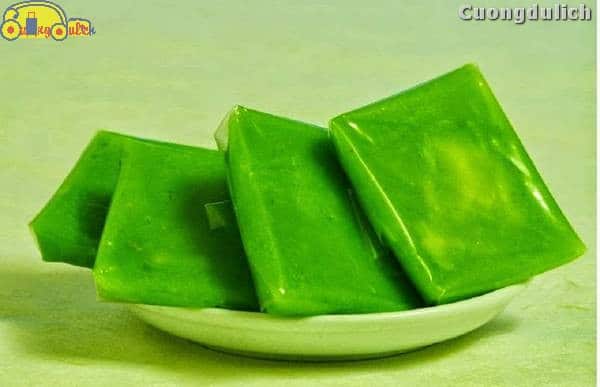
Bánh cốm is a traditional dish that often appears at engagement ceremonies, accompanied by bánh phu thê to create a beautiful pair of green and red cakes. With a fresh green cốm outer layer, yellow mung bean filling, and the distinctive aroma of young cốm, just the smell alone is enticing.
The most delicious bánh cốm is sold at Nguyên Ninh shop, located at house number 11 Hàng Than. To this day, Nguyên Ninh still sells bánh cốm using the traditional handmade method from ancient times. The cakes have a fresh green color, thin and light crust, and you can even see the yellow mung bean filling inside. The fragrant aroma of cốm blends with the coconut and mung bean scents, making it irresistible.
Although bánh cốm may look simple, it undergoes a meticulous cooking process. Starting from selecting the ingredients, choosing the right cốm and mung beans requires great care. The Nguyên Ninh family emphasizes that the most important aspect of making bánh cốm is the cốm roasting process. Even the younger generations in the family have to study for years to master the art of roasting cốm to ensure the original flavor. Additionally, the distinctive feature of Nguyên Ninh’s bánh cốm is that it is made purely from cốm without any added flour, and it is not ground to preserve the flavor. Skipping the grinding step while maintaining a smooth crust is the secret recipe passed down in the Nguyên Ninh family.
Eating a piece of bánh cốm is like experiencing the autumn in Hanoi, with the fragrant aroma of cốm and the abundance of ripe cốm grains, and the hands of the vendors selling cốm are fragrant. Enjoying a sweet and rich bánh cốm seems to embody the deep meaning of Hanoi’s people, wishing for everlasting love and sweetness for couples through generations.
When in Hanoi, do not forget to buy small boxes of bánh cốm as gifts for your family and friends, as bánh cốm represents the elegance and essence of the capital’s cuisine. The price of each Nguyên Ninh bánh cốm is very affordable, only 5k for a small cake, 6k for a large cake, and 50k for a box of 10 cakes. Some other delicious bánh cốm shops on Hàng Than street include Bánh Cốm Bảo Minh at 12 Hàng Than, and Bánh Cốm An Ninh at 49 Hàng Than…
1.6 Bún thang
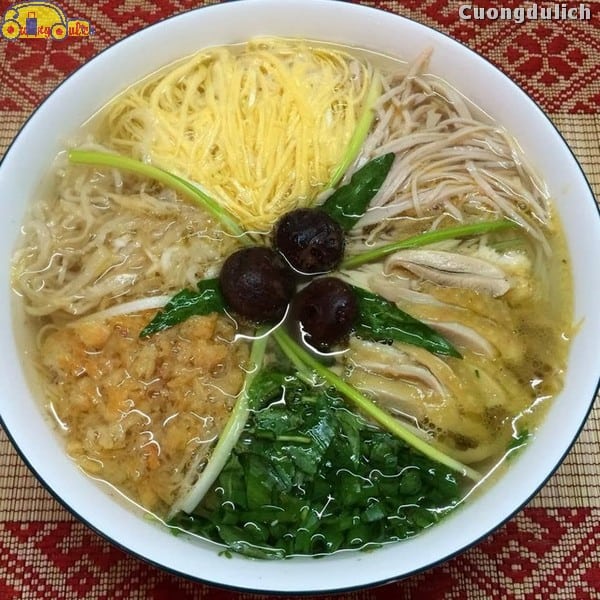
“Bún thang” is a dish that is praised for its complexity in presentation and preparation. The overall bowl of “bún thang” looks like a colorful flower with the yellow of eggs, pink of “giò lụa” (Vietnamese pork sausage), white of chicken meat, and golden chicken skin, alongside slightly yellowed julienned carrots, interspersed with brown shiitake mushrooms and red-orange shrimp floss. On top are layers of scallions, cilantro, and enticing slices of red chili.
To cook a standard bowl of “bún thang” correctly, it is generally extremely intricate, sometimes taking a whole day to prepare. First, you need the noodles. The noodles should be thin but not too thin, just right so that when mixed with the “giò lụa,” they complement each other. Next is the chicken. Whether it’s a rooster or a hen, as long as the meat is tender and fatty. However, the meat placed on the dish should be chicken breast, finely shredded, then placed in one corner of the bowl, next to the “giò lụa.” Then comes the egg.
The egg must be thinly beaten – actually, beating the egg thinly is quite difficult, then it is also shredded and placed in another corner of the bowl. “Bún thang” will be even more delicious with the addition of shrimp floss. Not many “bún thang” stalls in Hanoi still have shrimp floss. Firstly, because it is too expensive, and secondly, the process of making a batch of shrimp floss is also intricate and time-consuming. Therefore, it can be said that “bún thang” is the most complex dish among the specialties of Hanoi.
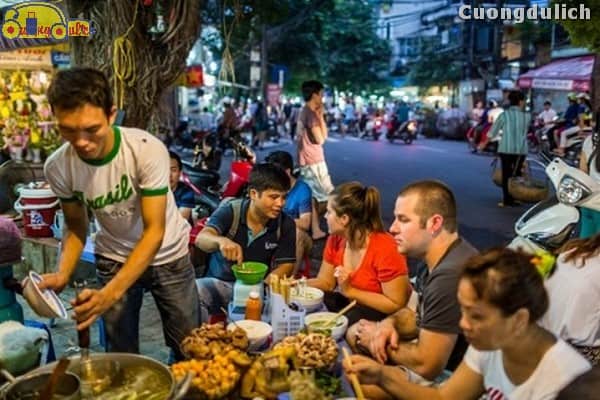
When eating “bún thang,” you can’t miss the pickled radish, a few mushrooms, a drop of “cà cuống” essence on the tip of the chopsticks, and especially after all those delicate flavors, a bit of shrimp paste. A flavor that seems unrelated to everything already in the bowl of “bún,” yet when combined, it creates a unique taste that cannot be replicated.
All the ingredients, from the noodles to the pork leg, chicken, eggs… mentioned above are already intricate from preparation to the final dish, but boiling a pot of water to cook the noodles is even more complex.
Usually, housewives choose chicken bones and pork ribs, blanching the bones in hot water to remove impurities, simmering gently and skimming off any foam that clings to the pot, ensuring the broth is as clear as possible. The broth for “bún thang” cannot be without dried shrimp heads. These dried shrimp heads have a very distinctive flavor that enhances the broth. Some people like to add a few pieces of dried grilled squid, which adds sweetness or a dry umami taste to the broth. However, some prefer the broth to have only the flavor of dried shrimp heads.
In the past, people in Hanoi only ate “bún thang” during the Lunar New Year. After the holiday, there was an abundance of leftover food. Instead of wasting it, housewives came up with this excellent dish. It became a light and refreshing dish after three days of indulging in “bánh chưng,” chicken, and bamboo shoot soup during the New Year. Nowadays, you don’t have to wait until Tet to travel to Hanoi and enjoy “bún thang.” Now, when you travel to Hanoi, you can enjoy “bún thang” all year round because there are many delicious eateries in Hanoi serving this exquisite dish.
If you travel to Hanoi and explore the Old Quarter, you can stop by “bún thang” restaurants like 48 Cầu Gỗ, have a bowl of “bún” to satisfy your hunger, then wander the small streets of the capital, or try “bún thang” at 29 Hàng Hành, “bún thang” at 11 Hàng Hòm, “bún thang” at Thuận Lý Hàng Hòm… Each bowl of “bún thang” costs around 50k VND but contains the full culinary philosophy of the people of Hanoi. The rich ingredients combined together create a dish that is pure and simple, the name “Thang” meaning a dish with many components combined together like a traditional Chinese medicine prescription.
1.7 Snail Noodle Soup
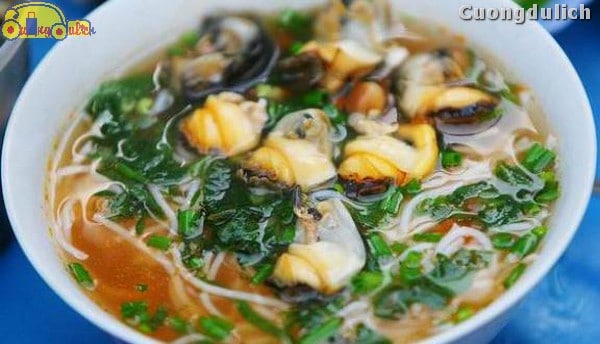
Bún ốc has long been a must-have dish in the menu of Hanoians and visitors to the capital city. It seems like you have to eat bún ốc in Hanoi. This rustic dish, through the skilled hands of the women in Hanoi, becomes a sophisticated culinary delight like nowhere else.
The three most important elements to create an appealing dish are fatty snails, fragrant lemongrass, and flavorful broth. Additionally, there are tangled vermicelli, fresh herbs, scallions, tomatoes, chili powder, a touch of shrimp paste, and pork bones.
The best bún ốc is made with apple snails, a type of snail with a shiny purple-green color on its shell. The delicious, crunchy meat, combined with the rich, creamy yellow substance of the snail, makes diners enjoy it more and more.
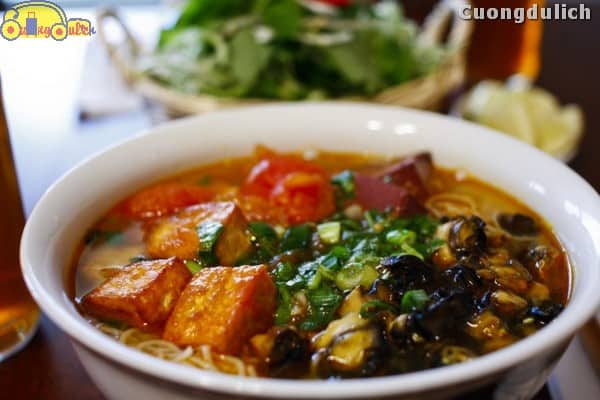
Nhà văn Thạch Lam once wrote about people eating snail vermicelli soup like this, “people gather to eat snail vermicelli soup in a new, delicious way! Have you ever passed by Ms. Đào’s house at noon or late at night, and the young ladies, seeing them eat that gift so attentively and earnestly? The sour snail broth wrinkles the tired faces, the spicy chili makes the lips tingle, and sometimes even makes the tears more honest than the tears of love.”
Snail vermicelli soup is Cuồng’s favorite dish. The crunchy snails, when chewed thoroughly, have a rich and fatty taste, the sour and refreshing broth with a hint of lime and vinegar suddenly becomes fragrant, and the strong spicy taste of chili sauce. Eating snail vermicelli soup in the hot summer or in the cold winter weather warms the stomach.
Cuồng would like to introduce you to some famous and delicious snail vermicelli soup restaurants in the Old Quarter for you to enjoy when traveling to Hanoi: Mrs. Thêm Hàng Chai’s snail vermicelli soup, the snail vermicelli soup street on Hòe Nhai street with dozens of crowded snail vermicelli soup stalls, Mrs. Huê Đặng Dung’s snail vermicelli soup, Mrs. Huệ Hàng Giày’s snail vermicelli soup, Mrs. Giang Lương Ngọc Quyến’s snail vermicelli soup. Each bowl of snail vermicelli soup costs around 40-50k depending on whether you want to add snails, pork, beef, fish cake, etc.
Mrs. Thêm Hàng Chai’s snail vermicelli soup restaurant has a long tradition of making snail vermicelli soup, passed down through 3 generations in Mrs. Thêm’s family, so the snail vermicelli soup here always has a special taste of traditional cooking. The slightly sweet and sour broth, the sweet taste of snails, and the spicy flavor of fresh chili have delighted many diners. A hint of shrimp paste scent rises, not strong but very fragrant and pleasant. The golden, crunchy, fatty, and chewy snails.
A bowl of vermicelli only has a few sprigs of green onions, a few pieces of tomatoes, and a few herbs, but it’s enough to attract diners. If you want to be a bit fancier, you can add some beef slices to enhance the flavor. That’s why Mrs. Thêm’s snail vermicelli soup sells out early in the morning, making many customers leave disappointed or have to wait quite a long time.
1.8 Bánh cuốn
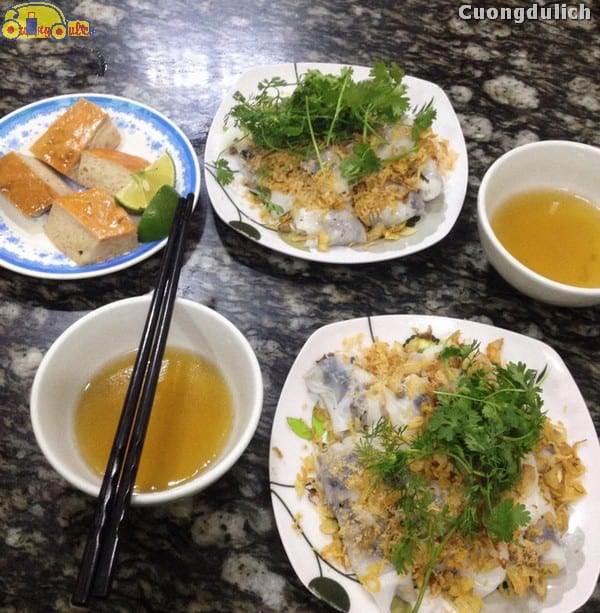
What could be better than a morning in Hanoi, sitting leisurely enjoying each soft and smooth piece of delicate white rolled cake, while admiring the surrounding scenery. The banh cuon is soft and smooth, with a hint of the fragrance of minced pork, mushrooms, and fried shallots.
The banh cuon is eaten with a dipping sauce made from lean pork, salt, spices, sugar, a little bit of dark soy sauce, without fish sauce, making the dish even more delicious and flavorful. The cake batter is made from wet-ground rice, so it is very smooth. After being cooked by steam, the cake sheet is rolled with a filling of cooked minced pork, minced mushrooms, and fragrant mushrooms. The dipping sauce for banh cuon is pre-mixed with some minced meat and mushrooms in a very unique broth. This dish is light and refreshing, making you want to have a second serving after finishing the first one.
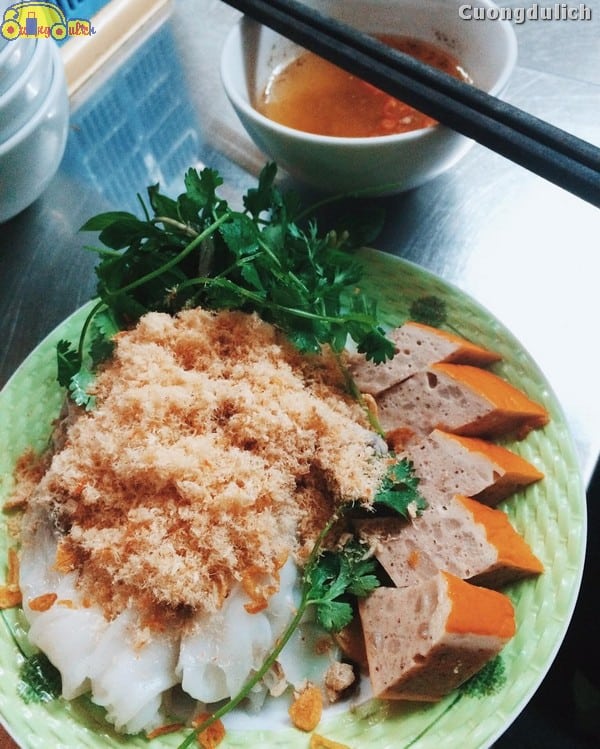
In the famous rice roll alleys in Hanoi’s Old Quarter, Thanh Van rice roll is located at 12-14 Hang Ga, Quang An Hang Bo rice roll, and Phuong 68 Hang Cot rice roll. The price for a serving of rice rolls is around 50k. It can be said that Thanh Van rice roll is also one of the addresses that are no longer unfamiliar to most Hanoians. Thanh Van rice roll is famous for its long-standing tradition. The restaurant is very easy to find, right on the main street, but the parking space is quite cramped.
What makes Thanh Van rice roll stand out from other rice roll shops in Hanoi is that besides the sprinkled fried shallots on the layer of soft rice roll wrapping the round flavored filling, there is also fragrant shrimp floss added.
The rice rolls here are cleverly transformed, making the dish more unique and less monotonous with 4 different fillings: pork rice roll, chicken rice roll, egg rice roll, and shrimp rice roll…
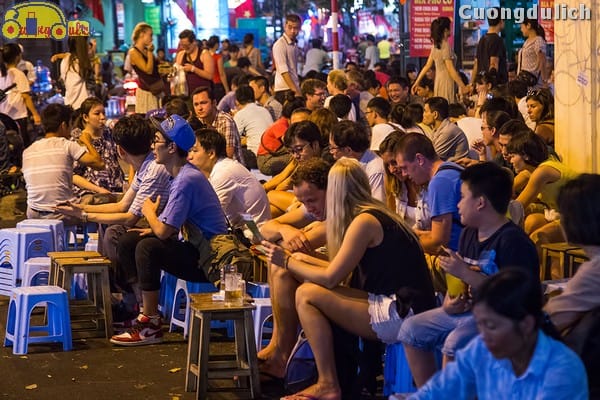
Furthermore, you can also try many other delicious dishes from Hanoi such as West Lake shrimp cake made from big, fat, and rich shrimp; West Lake ice cream, which has been priced at around 5k per piece for years; Trang Tien ice cream (wandering around the Old Quarter of Hoan Kiem Lake, you will see in both summer and winter, many tourists gather to buy ice cream at the crowded shops along Trang Tien street); rolled pho; stir-fried pho; crab noodle soup; pyramid-shaped rice dumplings; baguette… Baguette, a dish not originally from Vietnam but after many years of importation has become a common breakfast for children going to school, for adults to fill their stomachs before going to work, and only in Hanoi, baguette has become a delicious street food with many different variations such as shredded pork, pate, grilled meat…
If young travelers visiting Hanoi want to explore the nightlife here, they can hang out at lemon tea shops near St. Joseph’s Cathedral, West Lake, the Opera House… Hanoi is the cultural and economic center of the country, so there are always coffee shop chains, bubble tea shops… imported from abroad for you to enjoy a change every evening.
What do you think? Hanoi has countless delicious dishes that you need to spend a few days wandering the streets when traveling to Hanoi to taste them all. Hanoi’s street food is diverse with many delicious and affordable dishes. The special thing is that when traveling to Hanoi, you don’t need to go to fancy expensive restaurants to enjoy the capital’s cuisine, just turn into a small alley, or stop by a makeshift food stall on the sidewalk, on the pavement with the vendor’s cart and a few small plastic chairs.
Eating right on the sidewalk, on the pavement, you can also discover the bustling daily life of the people and understand more that, despite changes in life, society’s development, the sophisticated and refined eating habits of Hanoians for generations remain unchanged to the point of elevating the preparation and enjoyment of delicious dishes into an art form.
2. Eating experience in Hanoi to avoid being ripped off
If you want to travel to Hanoi and indulge in delicious dishes without worrying about being overcharged, then check out the following tips compiled by Cuong!
2.1 Researching restaurants online beforehand
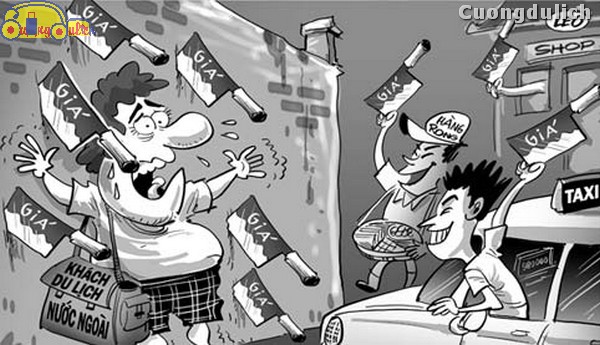
Just like anywhere else, when visiting the capital city of Hanoi, you should carefully research information such as prices of services, reputable dining locations… This will help you avoid falling into the traps of those who overcharge or avoid places that often rip off customers. Additionally, this will help you understand more about the culture, habits, and differences of Hanoi compared to other regions. Compared to the general cost of living, prices of some services in Hanoi are usually higher.
Currently, food review websites for Hanoi are very popular online. You can visit these sites to find addresses of good and affordable eateries in Hanoi to enjoy the specialties of the capital without worrying about breaking the bank. Moreover, you can avoid low-quality but expensive eateries, tourist traps, or even dodge places where sellers curse at customers, like noodle or porridge shops in Hanoi where the vendors scold customers as if they were singing. However, if you can enjoy a good meal despite hearing some harsh words or want to try a bowl of scolding noodles, you can give it a shot.
2.2 Choose eateries with displayed menus or inquire about prices before dining
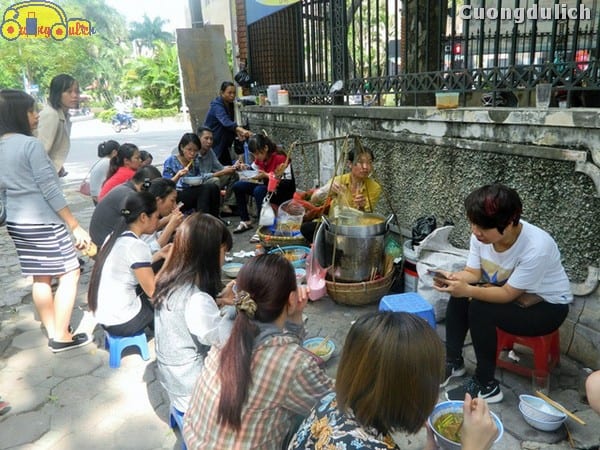
Hanoi is a paradise for sidewalk food stalls, but the street food culture here can sometimes be challenging for tourists. Finding a menu with prices listed at these eateries is not easy. In fact, many places display prices with three digits (0) at the end, leaving out the important first digit. If you ask, they will clarify the price. However, easygoing customers may end up being charged exorbitant prices.
Therefore, when entering any establishment, it’s advisable to ask for prices before eating, as it may be difficult to dispute the bill after finishing the meal. This may annoy the restaurant owner a bit, but it’s better than being surprised by a high bill later. Some places, even after agreeing on a price, may still charge different amounts for additional items like side dishes or condiments.
To attract tourists, many restaurants often offer very attractive prices, but then add on additional fees that can sometimes be 3-4 times the original advertised price. The most common trick is charging extra for vegetables, noodles, fish… in a hotpot dish, explaining that the price on the menu is only for the broth.
Usually, eateries provide complimentary condiments like lemon, chili sauce, even wet wipes and napkins. However, at tourist spots, customers may be charged for using these items. Therefore, before using or requesting anything extra, it’s advisable to ask if there’s a charge. This is not uncommon in some “fast-food” style eateries. To be sure, you can opt for immediate payment.
2.3 Check the Bill Carefully
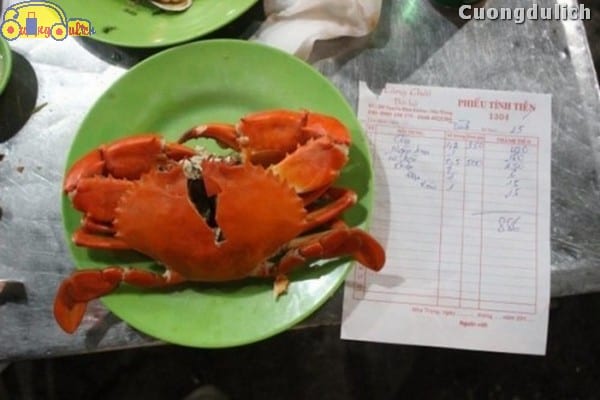
Aside from overcharging, many restaurants may try to deceive customers by adding extra dishes, plates, or even charging for items that were not ordered. Therefore, it is important to check the bill to ensure it accurately reflects the items ordered, the quantity of dishes served, and the total amount before making payment.
2.4 Don’t hesitate to bargain
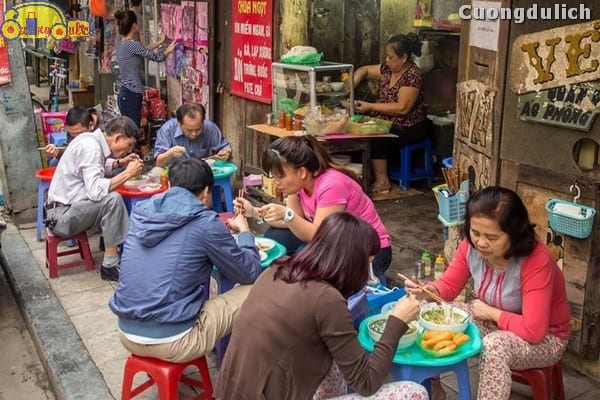
Not only in Hanoi, overpricing is a common issue at most tourist destinations around the world and in Vietnam. If you are not careful, you can easily fall victim to overpriced items and feel like you are being cheated, both in terms of money and emotions. Especially for foreign tourists or those with regional accents, some vendors in Hanoi tend to overcharge or quote sky-high prices, so you need to bargain before buying food. Many vendors in Hanoi assume that Western or overseas Vietnamese customers are wealthy, so they tend to shout out high prices as they believe these customers have money to spend and will only visit the shop once and leave, so they must make a good profit.
Many shops in Hanoi, especially in the Old Quarter, still follow the old practice of overcharging any customer they can because they believe that customers from afar will not know when they will return. With regular customers, it’s fine as the vendors are easy-going, sell at the right price, and sometimes even add extra broth or meat, but with new customers, the likelihood of being overcharged is very high. Therefore, you need to plan carefully about the places to visit, check online to see if the shop is known for overcharging customers, and don’t hesitate to bargain. If you are traveling to Hanoi and have someone in your group who is good at bargaining, even better, as you might end up enjoying Hanoi’s specialties at a surprisingly low price!
2.5 Hotline phone number
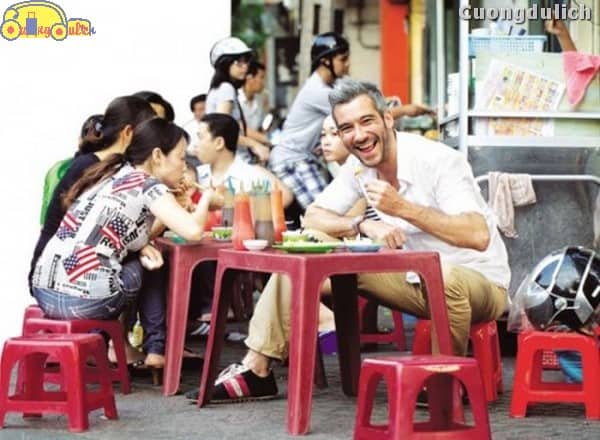
For those who are unfamiliar with the place and do not want to get into disputes while traveling, many tourists often choose to remain silent when being overcharged. However, this very action is what allows those who overcharge to continue their practices. The advice for tourists in such situations is to save the hotline number of local authorities to report when necessary.
The hotline for reporting overcharging, scams, fraud, and harassment of tourists in Hanoi is 0941336677. This hotline operates 24/7. Additionally, tourists can also visit the tourist support information desk at Ly Thai To Flower Garden on Le Thach Street to report.
2.6 Booking all-inclusive tours of Hanoi with travel companies
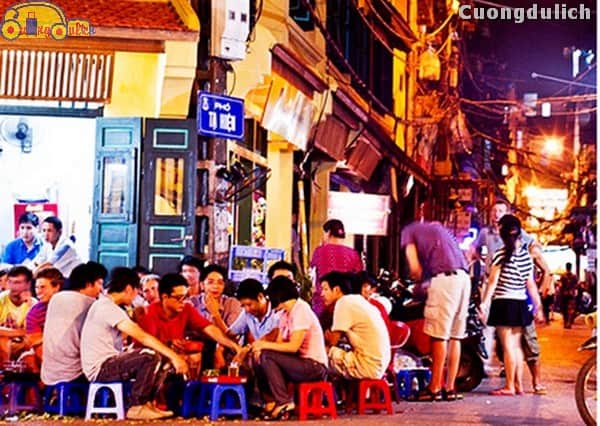
Finally, if you travel to Hanoi, you can book a full package tour with travel companies. Experienced guides will take you to delicious eateries to enjoy the specialties of Hanoi that they know the prices well, so you won’t have to worry about being ripped off. In addition, travel companies can also help you book hotel rooms, rent transportation, buy tickets to attractions, amusement parks, services, or even bargain when shopping to avoid being overcharged.
When traveling to Hanoi, don’t worry about being overcharged, it’s just because you haven’t chosen the right restaurants and negotiated skillfully, just ask for prices a little. Wishing you a trip to Hanoi with a full stomach and without worrying about spending too much money!
